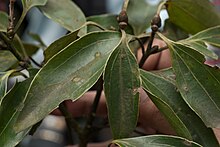This article needs additional citations for verification. (July 2023) |
| Cinnamomum osmophloeum | |
|---|---|

| |
| Scientific classification | |
| Kingdom: | Plantae |
| Clade: | Tracheophytes |
| Clade: | Angiosperms |
| Clade: | Magnoliids |
| Order: | Laurales |
| Family: | Lauraceae |
| Genus: | Cinnamomum |
| Species: | C. osmophloeum
|
| Binomial name | |
| Cinnamomum osmophloeum | |
Cinnamomum osmophloeum, commonly known as pseudocinnamomum or indigenous cinnamon, is a medium-sized evergreen tree in the genus Cinnamomum. It is native to broad-leaved forests of central and northern Taiwan.[2][3]
Cinnamaldehyde, an essential oil extracted from C. osmophloeum, has numerous commercial uses. Also, it is a xanthine oxidase inhibitor, hence a potential drug for treatment of hyperuricemia and related medical conditions including gout.[4]
- ^ Pan, F.J. (1998). "Cinnamomum osmophloeum". IUCN Red List of Threatened Species. 1998: e.T31334A9627359. doi:10.2305/IUCN.UK.1998.RLTS.T31334A9627359.en. Retrieved 19 November 2021.
- ^ Liao, Jih-Ching (1996). "Lauraceae". In Huang, Tseng-chieng (ed.). Flora of Taiwan. Vol. 2 (2nd ed.). Taipei, Taiwan: Editorial Committee of the Flora of Taiwan, Second Edition. pp. 433–499. ISBN 978-957-9019-52-1. Archived from the original on 4 March 2016. Retrieved 29 March 2013.
- ^ Xi-wen Li; Jie Li; Henk van der Werff. "Cinnamomum osmophloeum". Flora of China. Missouri Botanical Garden, St. Louis, MO & Harvard University Herbaria, Cambridge, MA. Retrieved 29 March 2013.
- ^ Wang SY, Yang CW, Liao JW, Zhen WW, Chu FH, Chang ST (August 2008). "Essential oil from leaves of Cinnamomum osmophloeum acts as a xanthine oxidase inhibitor and reduces the serum uric acid levels in oxonate-induced mice". Phytomedicine. 15 (11): 940–5. doi:10.1016/j.phymed.2008.06.002. PMID 18693097.
